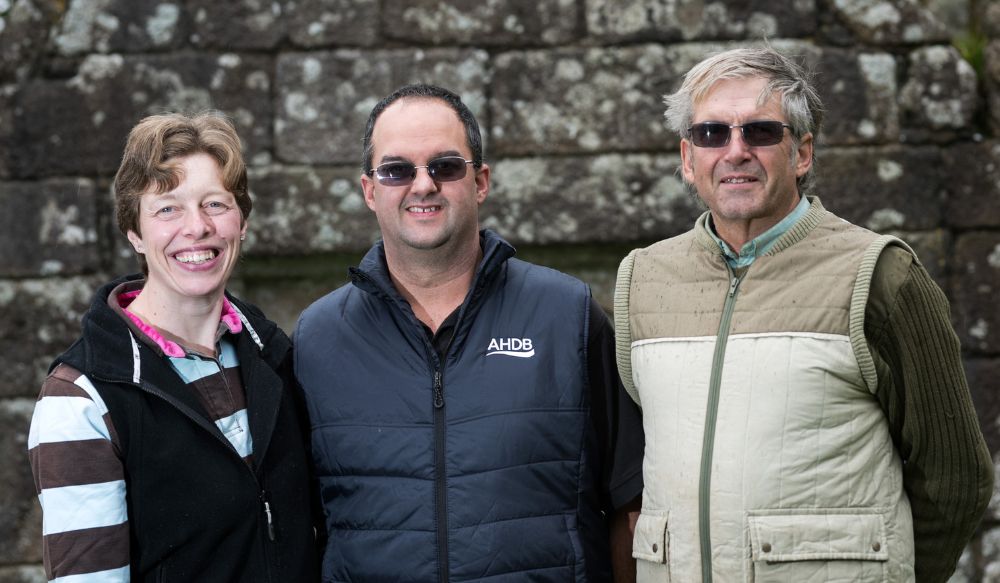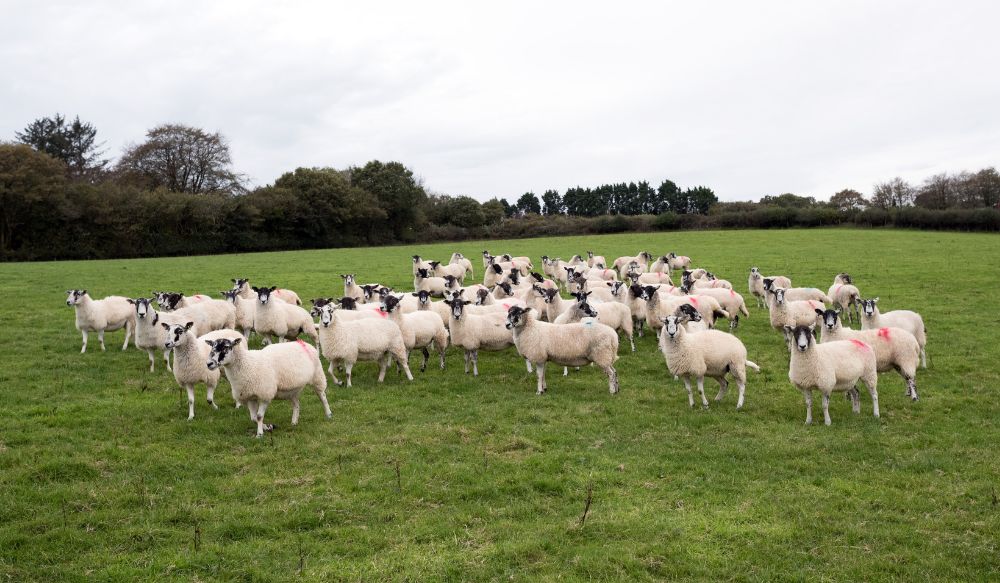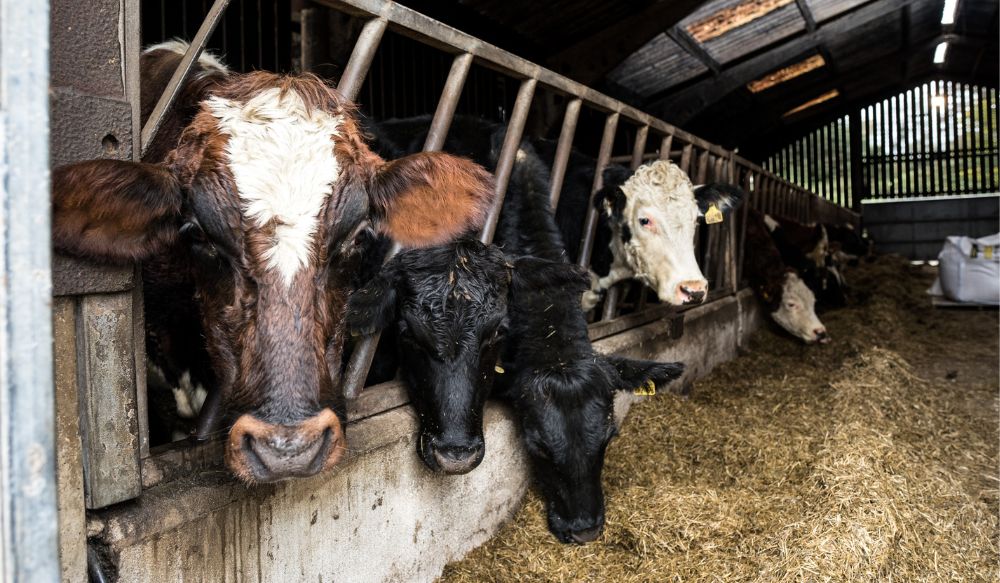Strategic farmer reaps rewards from grassland management changes
Monday, 30 October 2023
Adrian Coombe of Dupath Farm in Callington, Cornwall, has come to the end of his time as an AHDB strategic farmer. It has been a successful programme that he will continue to benefit from for many years and below we share some of the highlights and learnings. Adrian is also a farm partner in the RamCompare project – the UK’s commercial progeny test for terminal sires.
At the start of the Strategic Farm Programme, Adrian wanted to improve grassland management and the overall efficiency across his business.
Over the course of the last four years (2019–2023), he has implemented changes that have done just that, as well as improving the productivity and performance of his farm.
Some of his successes, along with continuing to benchmark his data, include:
- More than halving fertiliser use on farm
- Producing clamp silage with a protein level of 14.2% and a DM of 10.4 MJ/kg
- Reducing finishing times of cattle by six months
Adrian commented: “I am very thankful to have been part of the Strategic Farm Programme. It has given me the push and knowledge to make more informed decisions within my grassland management, which in turn is helping my business to be more sustainable and profitable.”
About Dupath Farm
Adrian farms with his wife, Lyn, and father, Peter, in Callington, Cornwall (pictured below).
 Len Copland
Len Copland
They have a mixed enterprise as follows:
- 150 ha of land, comprised of arable, sheep and beef enterprises
- Ewe numbers and breed: 620 North Country mules (500 ewes and 120 ewe lambs)
- Ram breeds: Charollais, Hampshire, Shropshire, Texel, Suffolk and Meatlinc
- Cattle numbers and breeds: 200 Aberdeen Angus-sired dairy crosses
- Other income: Christmas trees and a biomass boiler
Grassland management and fertiliser use
In early June 2021, Charlie Morgan, an independent grassland and forage specialist, suggested a number of reseeds for Dupath Farm, as well as cutting rotational grazing paddocks as and when the grass growth exceeded the requirements of the grazing system.
In 2021, the quality of Adrian’s clamp silage was, as a result, very good for a beef and sheep system, achieving:
- Dry matter: 31.5%
- Metabolisable energy: 10.4 MJ/kg
- Protein: 14.2%
In March 2022, a grazing management plan was discussed for the upcoming season. Charlie suggested cutting the silage earlier and taking two lighter cuts, rather than a first big cut and smaller second cut, to increase yield.
Adrian implemented this and the quality spoke for itself. Adrian’s goal is to maintain the quality and quantity he knows he can produce, year on year.
Charlie also proposed reducing fertiliser use (to lower input costs) in any of the paddocks where grass growth was particularly prolific.
In 2022, Adrian spread half the amount of fertiliser compared with 2021 because the grass growth met the demand from the system.
Plate metering and grass growth recording demonstrated a wedge had been created and that fertiliser wasn’t needed to increase it further. As a result, Adrian saved approximately £16,900 in fertiliser costs in 2022.
In August 2023, Adrian had only spread a third of the 25.9 tonnes of fertiliser he spread in 2021; there is the potential to reduce this further in 2024, depending on demand from the grazing platform.
The quality of the grass has also improved due to rotational grazing and Adrian has made additional efficiency savings, through reduced labour and fuel costs.
Adrian explained:
“Before taking part in the Strategic Farm Programme, we were spreading all the fertiliser in one application in the spring. As part of the programme, we were advised to split it into three to make better use of the nutrients.
“Following that, and with the aid of plate metering, we are spreading a third of the original amount in early March and then topping up if grass growth is below demand. This year, one application has been enough.”
Rotational grazing
Adrian had already begun rotationally grazing his sheep flock before starting the Strategic Farm Programme.
Liking what he saw, in 2019 Adrian successfully introduced his cattle to the rotational grazing system on one area of the farm, moving away from traditional set-stocking.
Following its success, the rotational grazing system was replicated on all other areas of the farm and since then all stock has been rotationally grazed at Dupath Farm during the grazing months.
 Len Copland
Len Copland
Cattle are housed over winter to rest part of the grazing platform and to decrease demand on the grazing remaining for the sheep. The ewes are housed from early January until lambing in March to provide the grazing platform with the break it requires before the grass begins to grow again.
Despite the successes of changing the grazing management at Dupath Farm, adverse weather events still pose a challenge.
On reflection, during the drought in 2022 Adrian acknowledges that he should have given the cattle a sacrifice paddock as grass growth slowed, instead of continuing with frequent moves while feeding hay. He had to play catch-up during the September and cattle continued to be supplemented with hay, which, although wasn’t part of the plan, did have the added benefit of introducing more clover (via seed in the hay) to the fields.
Leah Shanks, AHDB Knowledge Exchange Manager, commented:
“Without a doubt, rotational grazing systems provide more resilience to drought challenges than set-stocked grazing. However, each system does, of course, have its limits.
“Adrian would be the first farmer to admit that you can’t learn all there is to know about rotational grazing overnight, it takes years, but it certainly provides you with more options and time to mull them over before making an informed decision.”
Cattle finishing
At the beginning of the Strategic Farm Programme, Adrian knew that he wanted to maximise his home-grown forage to finish cattle faster. He set himself the target of ≤24 months, rather than the 28–30 months that was standard at Dupath Farm.
 Len Copland
Len Copland
In January 2023, Adrian sold 14 Angus dairy crosses averaging ~560 kg liveweight at 22 months of age – six months younger than his previous stock of a similar breed. This was a result of weighing cattle regularly, implementing rotational grazing and supplementing with high-quality, home-grown silage as well as some concentrate feed during the winter housed months.
Adrian is now selling 100 finished cattle annually, compared with 80 in previous years.
Charlie set Adrian the target of turning out cattle during the first week of April, three weeks earlier than usual if the wedge was ahead of them, rather than during the last week of April.
This would enable cattle to gain an additional ~30 kg liveweight each from grass before the following year’s winter housing and reduce reliance on the winter ration to finish animals.
If the weather is wet, Adrian has the option of rotationally grazing paddocks for one day, rather than three, to minimise poaching; if grazing is minimal, cattle can be supplemented with home-grown silage.
Adrian explained: “Rotationally grazing the cattle has meant we can keep higher-quality grass in front of the cattle, thus improving daily liveweight gain and finishing times.”
Farmbench
Having been familiar with AHDB’s Farmbench tool prior to getting involved with the Strategic Farm Programme, Adrian was keen to continue benchmarking to inform his business decisions as the programme progressed.
Adrian has been benchmarking for around 10 years and it is second nature to him and his business. Adrian even changed the titles of his accounts to match those in Farmbench to make life easier for himself when copying his data into the tool.
Commenting on Farmbench, Adrian said:
“If I didn’t think it was worth doing, I wouldn’t carry on doing it.”
Leah added:
“You can’t manage what you don’t measure, and for Adrian, collecting data is a really important part of his operation at Dupath Farm.”
Find out more and join Farmbench
Strategic Farm Programme
Our network of Strategic and Monitor Farms open their businesses to share best practice and practical demonstrations of the latest research and advice from AHDB. They also provide networking opportunities through farmer discussion groups.
Throughout the year, our farmers host on-farm and online events, giving you access to industry experts and a network of like-minded farmers. Topics include grass and forage, animal health and welfare, genetics, farm performance and much more.
Like many beef and lamb farmers, our Strategic Farms and Monitor Farms represent a diverse mix of systems located across the country, all with experience of different land typography, rainfall and soil type.
Although Adrian and the other 2019 Strategic Farm cohort have now finished their projects, we facilitate four Monitor Farms across England.

